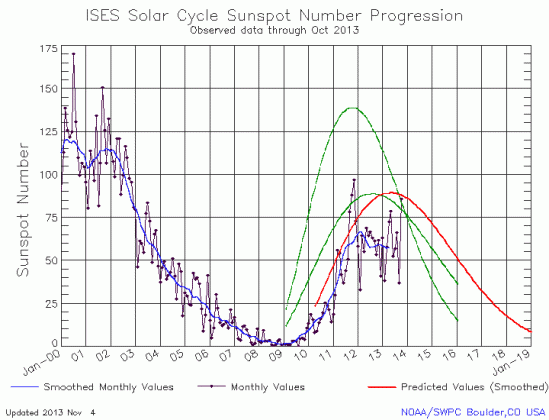The sun goes boom!
It is always best to admit when you are wrong as soon as you find out. Last month, in reporting NOAA’s monthly update of the solar cycle, I unequivocally stated that
My interpretation of this data tells me that almost certainly the solar maximum has ended. We might see some later fluctuations whereby the sunspot number jumps, but the Sun is clearly beginning its ramp down to solar minimum.
Well, I spoke too soon. Last night NOAA posted the newest update of the solar cycle, and it shows that in October the Sun was more active then it has been in two years. In fact, for only the second time this entire solar cycle the Sun’s sunspot activity actually came close to matching the predictions of scientists. This month’s graph is posted below the fold, with annotations.

The graph above has been modified to show the predictions of the solar science community. The green curves show the community’s two original predictions from April 2007, with half the scientists predicting a very strong maximum and half predicting a weak one. The red curve is their revised May 2009 prediction.
The number of sunspots leaped to the highest in two years, since October 2011 when the actual peak of the solar maximum took place. This new peak confirms that the Sun is now undergoing its the predicted second peak in this solar maximum.
As I noted on November 2, the Sun high active in recent weeks has almost all been in its southern hemisphere, suggesting that that hemisphere is getting ready to finally flip its magnetic field, as the northern hemisphere has already done. It is that event that will finally signal the end of the solar maximum.
Despite this month’s jump in sunspot numbers, however, the the solar scientists at the Marshall Space Flight Center this week adjusted their prediction of the intensity of the solar maximum downward. While previously they had said that the maximum would have a sunspot number of 66 in the summer of 2013, they have now lowered that number to 65 in the summer of 2013.
This change is not really a prediction, however. Instead, it is likely a revision of their prediction to match the real numbers for this summer, when the Sun was not very active. The timing of this revision also suggests that the high numbers this last month will do little to change numbers for the overall maximum. Thus, this maximum was very weak, the weakest in a century.
Moreover, the rise in sunspots in October really changes nothing in connection with the basic mysteries of this science. The real scientific questions remain: Why has the Sun become so reluctant to produce sunspots in the past seven years? Will that reluctance extend into a new Grand Minimum, the first in 400 years, where the sunspot cycle will end and Sun will produce no sunspots for decades? And if a grand minimum does happen, will the lack of sunspots affect the Earth’s climate, causing it to cool significantly as has apparently happened during past grand minimums?
Other unanswered science questions: If the lack of sunspots does cool the climate, how does it do it? The evidence so far compiled does not provide scientists an answer. During past solar minimums a quiet Sun did not reduce the Sun’s brightness enough to significantly influence the climate. How much the Sun dims during a grand minimum however is unknown.
All these questions remain unanswered. All of them are important, not just for solar scientists but for the entire climate science community as well as the general public. For if the Sun’s influence on climate change is more than scientists have been predicting for the past two decades, than all climate change policy must be changed. We might, for example, be heading towards global cooling, not global warming, should another grand minimum begin in the coming years.
On Christmas Eve 1968 three Americans became the first humans to visit another world. What they did to celebrate was unexpected and profound, and will be remembered throughout all human history. Genesis: the Story of Apollo 8, Robert Zimmerman's classic history of humanity's first journey to another world, tells that story, and it is now available as both an ebook and an audiobook, both with a foreword by Valerie Anders and a new introduction by Robert Zimmerman.
The print edition can be purchased at Amazon or from any other book seller. If you want an autographed copy the price is $60 for the hardback and $45 for the paperback, plus $8 shipping for each. Go here for purchasing details. The ebook is available everywhere for $5.99 (before discount) at amazon, or direct from my ebook publisher, ebookit. If you buy it from ebookit you don't support the big tech companies and the author gets a bigger cut much sooner.
The audiobook is also available at all these vendors, and is also free with a 30-day trial membership to Audible.
"Not simply about one mission, [Genesis] is also the history of America's quest for the moon... Zimmerman has done a masterful job of tying disparate events together into a solid account of one of America's greatest human triumphs."--San Antonio Express-News


It will be interesting to see what is learned from the double peak.
Bracing for the minimum here, at least the part I may witness in my lifetime! Keep those hydrocarbons going, we need more warming, especially since actual global temperatures have been outside the lower edge of the 95% certainty of the IPCC models.